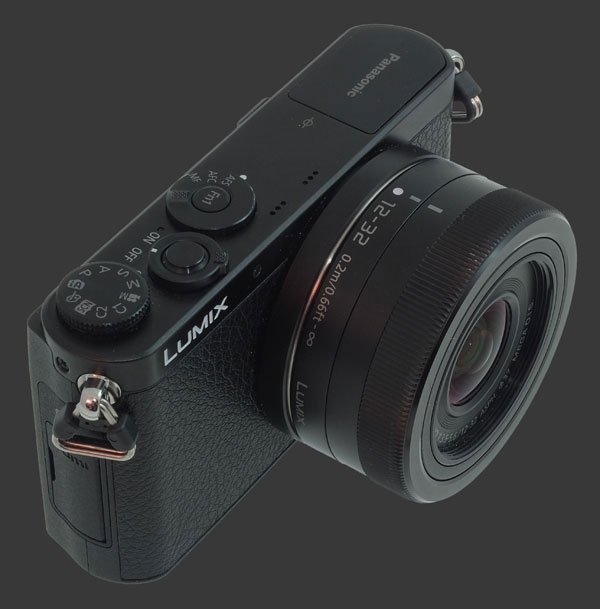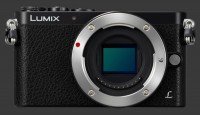Panasonic Lumix DMC-GM1 Review
Panasonic Lumix DMC-GM1 Performance - How well does it take pictures?
Performance starts with image quality, which is the criteria used as the foundation of our digital camera ratings. Ergonomic issues may get in the way, but in the end, image quality counts the most. For an ILC, image quality greatly depends on the lens used. While color, noise, exposure and dynamic-range are properties of a camera, distortion, vignetting and chromatic aberrations are properties of the lens. Sharpness and contrast depend on the weakest link. That is, a camera cannot capture more details than a lens lets through. Conversely, it is possible for a lens to transmit more details than a sensor can capture.

Image Noise & Details
The Panasonic Lumix DMC-GM1 shows good image quality with low image-noise up to ISO 800. Noise-reduction can be adjusted in 11 steps, more than most cameras. This ranges from virtually no removal to brutally destroying image details. At -3, noise-reduction does a nice job of balancing details and image-noise which is almost entirely achromatic.
Noise is actually visible at ISO 1600 but details are nicely retained. ISO 3200 is more noisy and details start being affected. This reduces possible print sizes a little. At 16 megapixels though, images remains perfectly acceptable for most users. ISO 6400 shows more intrusive noise but manages to make reasonable mid-size prints.
As one would expect, ISO 12800 is very noisy and details are mushy. Mid-size prints remain acceptable and small prints come out clean. ISO 25600 can just pull-off a small print and is usable emergencies. Image parameters are extremely flexible with small granular steps that make tweaking the output to taste easily.

Sharpness from the GM1 is quite good. The default setting leaves some general softness though. Pushing it to +2 improves things while introducing minimal artifacts. For anything but the closest inspection, there will not sure and make most prints look better.
Color & White Balance
Color accuracy is good but never perfect. Saturation tends to be exaggerated by all styles at their default settings. Starting at Natural and reducing Saturation to -2 gives the most realistic results. Contrast is nice at 0, which is the default.
Automatic While-Balance performance is better than average. It compensates well for a good variety of lighting, producing results with a minimal cast under most conditions. To perfectly control color-balance, Custom White-Balance is spot on. One very welcome feature of the GM1 is that the LCD can be adjusted in terms of Saturation and Tint along 2 axis. This makes it possible to calibrate the display so that it correctly previews white-balance. What this effectively does is allow white-balance fine-tuning to to be set reliably.

Exposure
The Panasonic GM1 has a nicely balanced multi-segment metering system which favors conservative exposures. Overexposure happens regularly in the presence of small highlights but also with moderately-sized ones in scenes of high contrast. Under-exposure is not much of an issue but does happen. Overall, this camera produces optimal exposures more often than not. When it misses, it rarely does by more than 1 EV.
Given that this camera offers two shutters, its behavior at extremes of brightness can be surprising. When using the ultra-quiet Electronic-Shutter, it can capture extremely bright scenes with shutter-speeds up to 1/16,000s. The Mechanical-Shutter, however, only attains a maximum of 1/500s. In low-light scenes, the situation is reversed with the minimum shutter-speed of 60s only possible mechanically. Otherwise, exposures are limited to 1s.
It is important to remember that the LCD is rarely Exposure-Priority so it only previews exposure for scenes which fall well within the metering range while the camera is in an automatic or semi-automatic mode. The optional live-histogram is not entirely reliable either since it represents the display and not the exposure. In Manual mode, the display can optionally be Exposure-Priority.

Auto Focus
This mirrorless digital camera has a quick Contrast-Detect autofocus system. It usually locks focus quickly and accurately. Even under moderate light it takes under ½s to lock focus. It can take a little longer in low-light, up to 1s in extreme conditions. This is a good performance and compares with recent mirrorless cameras.
To speed things up, Panasonic provides an option called Quick-AF. In this mode, the Panasonic Lumix DMC-GM1 starts focusing as soon as the camera is held steadily, presumably because the photographer is preparing to take a shot. When the shutter-release is pressed halfway, the GM1 then only needs to adjust focus a little.
Speed
The Panasonic GM1 is very responsive. Every button press and dial turn is immediately registered. This is just as good as any modern mirrorless camera. Its performance is characterized by the following numbers:
- Power-On: Just over 1 second, assuming the lens is not collapsed. Good.
- Power-On to First-Shot: 1½ seconds. Quite good.
- Autofocus: ¼-½s usually, up to 1s in low-light. Very good.
- Shutter-lag: Instant with under ¼s blackout. Excellent.
- Shot-to-shot: 1s with AF, 2/3s without. Average.
- Playback: Instant to enter, ½s to exit. Good.
- Power-Off: 2 seconds. Below average.
- Video: Instant to start. Great except that it cuts off the last second.
For an entry-level digital camera, the Panasonic Lumix DMC-GM1 is quite impressive. It matches much of the performance of higher-end models, except for throughput. Shot-to-shot speed are average but other important metric are great.
The one last and unsurprising number is battery-life. At 220 shots-per-charge, this is well below average but is certainly excusable considering the compact size of this camera and its battery. Particularly those who intend to shoot video should consider at least 2 spare batteries for a day of shooting.
Panasonic Lumix DMC-GM1 Conclusion

The truly compact Panasonic Lumix DMC-GM1 is an impressive achievement. Given it delivers mirrorless image-quality and speed from within a small body, one could easily consider it the best compact camera on the market. At least with a small lens. Combined with the Lumix G 12-32mm F/3.5-5.6 ASPH Mega OIS, it becomes exactly that: A small camera with exceptional image-quality.
As a mirrorless camera, it delivers a solid performance, particularly considering its entry-level feature set. Image-quality is good with low noise, nice color, good white-balance and reasonable metering. It lags a little in terms of dynamic-range and absolute sharpness, but there is little to complain about when it comes to output.
Crucially, the GM1 is a very responsive mirrorless. It is fast where it counts, like autofocus and shutter-lag. Video-recording also starts instantly. Unfortunately it also cuts off the last second when saving but that can be overcome. The worse performance of this camera comes from its short battery-life which is not so problematic either.
Its compact size is both a strength and a problem. The GM1 body is so small and cramped that controls are limited and difficult to use. The control-dial, in particular, is disappointing and causes accidental activation of touchscreen functions. Thankfully, that can be disabled. Buttons and dials are too small to be used while wearing gloves. With some practice, the dial can be used without inadvertently triggering functions assigned to the 4-way controller so often.
For simple point-and-shoot use, the GM1 is a compelling offering. Advanced users are likely to be frustrated by the user-interface. Incidently, Panasonic already announced the successor to this camera in the form of the GM5
Panasonic Lumix DMC-GM5 with an improved control-dial and even a built-in EVF, something which is sorely missed on the GM1. Still, the updated model is not as small which can understandably be a reason to choose the GM1 over it.
 |
Please Support Neocamera
All information on Neocamera is provided free of charge yet running this website is a huge endeavor. Purchases made via affiliate links found throughout the site help keep it running and up-to-date. There is no additional cost to you, so please consider buying via these links to our affilates:
Thank you for your support!
Panasonic DMC-GM1 Highlights

Sensor-Size: 17 x 13mm

Actual size when viewed at 100 DPI
| 16 Megapixels Mirrorless | ISO 125-25600 |
| Micro Four-Thirds Mount 2X FLM | Shutter 1/16000-60s |
| 2 Axis Digital Level | Full manual controls, including Manual Focus |
| Built-in Dust Reduction | Custom white-balance with 2 axis fine-tuning |
| 5 FPS Drive, 7 Images | Spot-Metering |
| 1920x1080 @ 30 FPS Video Recording | Lithium-Ion Battery |
| 3" LCD 1 Megapixels | Secure Digital Extended Capacity |
Updates
2025.11.13

Best Gifts for Photographers in 2025 by Budget
The annual Neocamera Photography Gift Guide updated to 2025. Find great gifts for photographers with any price budget.
2025.07.07

Stellar Photo Recovery Review
Review of Stellar Photo Recovery V12. This Windows and MacOS software can recover photos and videos in a huge number of formats from memory cards, USB drives, SSDs and HHDs.
2025.05.14

Huion Kamvas 13 Gen 3 Review
In-Depth review of the Huion Kamvas 13 Gen 3 Pen Display Tablet for photographers and graphic artists.
2025.01.18

Fujifilm GFX 2025 Lens Roundup
Lens Review roundup of Fujifilm GFX Medium-Format lenses. Quality, performance and handling of the GF20-35mm F/4R WR, GF30mm F/3.5 Tilt-Shift and the GF55mm F/1.7.
2024.11.18

Best 2024 Photography Gifts for Every Budget
Great gifts for photographers and photo enthusiasts selected for every budget among the best products of 2024.
2024.08.07

Eye Protection Tips for Professional Photographers
The four main considerations for professional photographers regarding eyewear.
2024.07.14

Fujifilm X100VI Review
Flagship fixed-lens compact digital camera with a 40 MP sensor and Image-Stabilization, a first for the series. Retro design featuring dual control-dials, plus direct ISO, Shutter-Speed and EC dials. Its hybrid viewfinder can switch between EVF and OVF mode.
2024.05.09

Fujifilm GFX100 II Review
Flagship 102 Megapixels Medium-Format Mirrorless Digital Camera with 8-Stop 5-Axis IBIS, 8 FPS Drive, 8K Video and 400 MP Super-Resolution capture in a weatherproof and freezeproof body with dual control-dials and dual memory-card slots.
2024.04.03

Fujifilm X-T5 Review
Newest Fujifilm flagship boasting a 40 MP APS-C sensor, 5-axis IBIS with 7-stop efficiency, 15 FPS continuous drive, 6.2K Video capture, dual control-dials and dual SDXC UHS-II slots in a sturdy weatherproof and freezeproof body.
2023.11.20

Best Digital Cameras of 2023
Find out which are the Best Digital Cameras of 2023. All the new Mirrorless Digital Cameras from entry-level to high-end professional.
2023.07.10

Fujifilm X-H2 Review
40 Megapixels APS-C Hybrid Mirrorless Digital Camera with 7-stop IBIS. Fastest shutter ever and 8K video capture. Large builtin EVF with 0.8X magnification and 5.8 MP, plus an Eye-Start Sensor. Packed with features and large number of controls in a weatherproof and freezeproof body.
2023.05.07

Sony FE 20-70mm F/4G Review
Review of the unique Sony FE 20-70mm F/4G lens. The optical zoom of this lens spans ultra-wide-angle and medium focal-length coverage, making it one of the most versatile Full-Frame lenses on the market.










